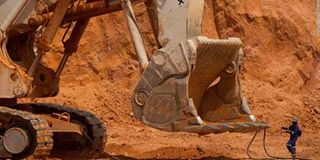Accident at Glencore mine kills at least 41 in Congo

What you need to know:
- The accident occurred in the KOV open-pit mine at the Kamoto Copper Company (KCC) concession.
- Artisanal mining on the edge of commercial mine sites is a big problem across Africa.
- The rudimentary, outdated and unregulated practices miners employ can often compromise.
At least 41 artisanal miners were killed on Thursday when part of a copper and cobalt mine owned by Glencore collapsed in southeast Congo, the provincial governor said.
The accident occurred in the KOV open-pit mine at the Kamoto Copper Company (KCC) concession, in which Glencore subsidiary Katanga Mining owns a 75 per cent stake, said Richard Muyej, the governor of Democratic Republic of Congo’s Lualaba province.
“It was caused by the clandestine artisanal diggers who have infiltrated (the mine),” he told Reuters. “The old terraces gave way, causing significant amounts of material to fall.”
“KOV is a delicate site and presents many risks,” he added.
Glencore said in a statement that it had confirmed 19 fatalities so far and was assisting search and rescue operations by local authorities.
Artisanal mining on the edge of commercial mine sites is a big problem across Africa.
The rudimentary, outdated and unregulated practices miners employ can often compromise safety: mine disasters in Congo alone cost the lives of dozens a year.
Thousands of illegal miners operate in southern Congo, which produces more than half of the world’s cobalt, a key component in electric car batteries.
Illegal miners
Glencore said an average of 2,000 illegal miners sneak daily onto the KCC concession, which spans a vast flat expanse on the outskirts of the city of Kolwezi near the Zambian border and is one of the country’s largest copper deposits.
Delphin Monga, provincial secretary of the UCDT union which represents KCC employees, said a crack in part of the pit had been noticed on Wednesday. He said KCC had put up red warning signs, but the diggers had ignored them.
This is not the first accident at the mine. In 2016, a 250-metre wall inside the KOV pit collapsed, killing seven mine employees.
Muyej said that the authorities were meeting to decide on new measures to secure large mines.
At least nine illegal gold miners died in Zimbabwe when they were trapped in a mine last month.
Twenty-two died in a previous Zimbabwean gold-mine flood in February, and 14 tin miners were buried alive in Rwanda after heavy rains in January.
In February, about 20 people died when a truck carrying acid to Glencore’s Mutanda Mine in DRC collided with two other vehicles.
Congo’s military deployed hundreds of soldiers last week to protect a copper and cobalt mine owned by China Molybdenum Co Ltd from illegal miners.
Shares in Glencore closed down 4.9%, their worst day of trading since December. The company said the incident has not affected output.
BMO Capital Markets analyst Edward Sterck said if the incident is related to illegal mining, any impact may be relatively short-term beyond an investigative period.
“However, preventative action will likely be needed and it could impact Glencore’s social licence to operate,” he added.
KCC produced a total of 152,400 tonnes of copper and 11,100 tonnes of cobalt last year. Glencore’s nearby Mutanda project produced 199,000 tonnes of copper and 27,300 tonnes of cobalt.




